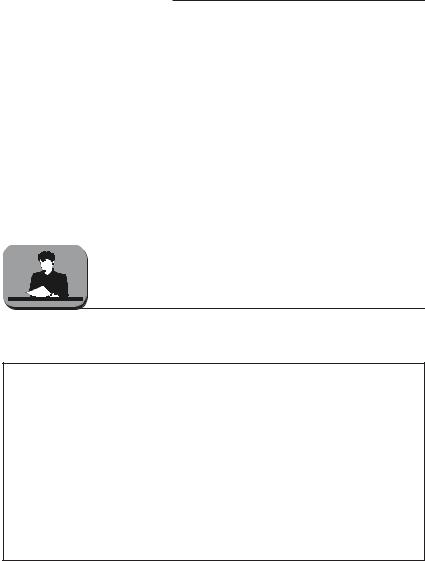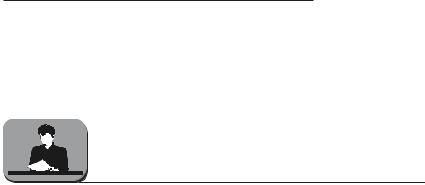
English для юристов. Гончар
.pdf
Part ІII. BUSINESS ENGLISH
Edit your copy carefully to avoid false or misleading claims. Read the e5mail over completely before sending it. Does it get your message across properly? Can you make it more exciting to read? Did you include your complete webpage URL? Did you use proper grammar and spelling? Are you sure the e5mail is still worth sending?
Once you do hit the send button, the e5mail will check itself for spelling. Be sure you have spell check turned on.
After the email is sent it will be copied to your sent file. You could then move specific sent emails into other folders for more efficient storage and sorting.
Email has great potential for personal and business use. Used correctly it can generate much good will. Used poorly it can hurt people and waste their time.
PRACTICE
1.There is a short example of email illustrating the features above. Translate in writing. Analyse its structure.
Hello Ted,
I’m sure you recall the August 1st meeting where we discussed the proposed venture capital funding of XYZ Inc. I’ve finished the paperwork for the next round and would like to ask you to look it over.
That is, if you are not too busy!
If it is okay with you, could we get together today at 3PM? Just let me know whether this time is convenient.
Regards,
Margaret
300

Module 11 Unit 2
2.1.Summary and Review
2.2.Annotation Writing Vocabulary in use
2.1.Summary
Pre reading tasks
1.Give the definition of the terms “summary” and “review” in English in your own words.
2.Try to explain their purpose in English.
Reading tasks
1.Read the text about summary and review to understand the difference between their types.
Types of Summaries
A summary should be accurate and while 100% objectivity isn’t possible, the summary writer should strive to stay as close as possible to this position. Most importantly, the summary writer should fairly represent the author’s ideas. Writers of summaries should save their own ideas and interpretations for the response (відгук), rather than including these things in the summary.
The purpose for the summary can alter (змінюватися) how it is written. Also, the reader’s needs and interests must be considered when writing a summary. A key skill to develop for use in written summary is the ability to paraphrase (to express the author’s ideas using the summarizer’s own words).
There are three types of summary:
• Main Point Summary
301

Part ІII. BUSINESS ENGLISH
•Key Points Summary
•Outline Summary
Outline Summary
This type of summary mimics the structure of the text being summarized. It includes the main points and argument in the same order they appear in the original text. This is an especially effective technique to use when the accompanying response will be analytic, such as an evaluation (оцінювання) of the logic or evidence used in a text.
Main Point Summary
A main point summary reads much like an article abstract, giving the most important «facts» of the text. It should identify the title, author, and main point or argument. When relevant, it can also include the text’s source (book, essay, periodical, journal, etc.). As in all types of summary, a main point summary uses author tags (фраза, клише), such as «In the article, the author states...,» or «The author argues/explains/says/asks/suggests...» These tags will make it clear which ideas are those of the author and the text being summarized, not the summarizer. This type of summary might also use a quote (цитування) from the text, but the quote should be re5 presentative of the text’s main idea or point. A main point summary is often used when writing academic papers as a way to introduce the reader to a source and to place the main point of that source into the context of an argument or discussion of an issue.
Key Point Summary
This type of summary will have all the same features as a main point summary, but also include the reasons and evidence (key points) the author uses to support the text’s main idea. This type of summary would also use direct quotes of key words, phrases, or sentences from the text. This summary is used when it is necessary for the summary writer to fully explain an author’s idea to the reader. The key point summary involves a full accounting and complete representation of the author’s entire set of ideas. One reason to use this sort of summary would be if the writer intended to respond to the author’s argument using an agree/ disagree response model. In such a case, there may be some of the author’s ideas that the writer agrees with, but others with which the writer disagrees.
302

Module 11. Unit 2
Review
The very word «review,» both as noun and verb, tells us what we should be doing. As the Latin root indicates, to review means to see again.
The first step in a review is to describe the work and its topic. The second task is to describe the work itself.
Review articles, including meta5analyses, are critical evaluations of material that has already been published. By organizing, integrating and evaluating previously published material, the author of a review article considers the progress of current research toward clarifying a problem. In a sense, a review article is tutorial in that the author
•defines and clarifies the problem;
•summarizes previous investigations in order to inform the reader of the state of current research;
•identifies relations, contradictions(суперечності), gaps (роз5 біжності), and inconsistencies(непослідовність) in the literature;
•suggests the next step or steps in solving the problem.
VOCABULARY IN USE
Read and analyse words, word combinations, clichés usually used in the writings.
The text (I’m reproducing) |
Текст (який я відтворюю) узято з... |
is taken from… |
|
The text is headlined… |
Текст має назву... |
The text (story,article) |
У тексті (оповіданні, статті) |
is concerned |
йдется про..., (пов’язана з...) |
with…(deals with…)... |
|
The subject of the text is… |
Темою тексту є... |
At the beginning (of the text) |
На початку (тексту) автор... |
the author… |
|
describes |
описує |
depicts |
змальовує |
dwells on |
детально зупиняється на... |
touches upon |
торкається ... |
explains |
пояснює |
introduces |
знайомить з |
303

Part ІII. BUSINESS ENGLISH
mentions |
згадує |
recalls |
нагадує |
characterizes |
характеризує |
analyses |
аналізує |
comments on |
коментує |
enumerates |
дає перелік |
points out |
вказує на |
emphasizes |
наголошує |
stresses |
наголошує |
underlines |
підкреслює |
generalizes about |
узагальнює |
criticizes |
критикує |
makes a few critical |
робить кілька критичних |
remarks on |
зауважень |
reveals |
викриває |
exposes |
розкриває |
accuses |
звинувачує |
praises |
позитивно оцінює |
gives a summary of |
коротко описує |
gives his account of |
дає короткий опис |
The article begins |
Стаття починається |
with a (the) description of… |
з опису |
The author begins with a (the) |
Автор починає з опису |
description of… |
|
The article opens with... |
Статья розпочинається з ... |
by mentioning |
згадки |
the analysis of |
аналізу |
a (the) summary of |
підсумку |
a comment on |
коментаря |
a review of |
огляду |
an account of |
звіту |
the characterization of |
характеристики |
(his) recollections of |
його думки про, його |
|
спогадів про |
some (a few) critical remarks |
кількох критичних зауважень |
about…(of, concerning) |
про... |
the accusation of |
звинувачення |
the exposure of |
викриття |
the (his) praises of |
(його) позитивної оцінки |
304

the generalization of
Then (after that, further on, next) The author
passes on to…
goes on to say that...
gives a detailed (thorough) analysis (description) of...
In conclusion the author…
The author concludes with… The article ends with…
At the end of the article the author draws the conclusion that…
(we make the conclusion that…)
To finish with the author describes… At the end of the article the author sums it all up (by saying…)
In the conclusion the author…
To sum it all up we should say…
Module 11. Unit 2
узагальнення
Потім (після цього, далі) Автор
переходить до...
хоче сказати, що дає детальний(ретельний)
аналіз (опис)...
На завершення автор...
Автор закінчує...
Стаття закінчується...
Укінці статті (на закінчення статті)
автор доходить висновку...
(ми доходимо висновку що...)
Укінці статті автор описує...
Укінці статті автор
підсумовує усе вищевикладене
(говорячи...)
Укінці статті автор...
Упідсумку нам слід сказати...
2.2. Annotation
Pre reading tasks
1. Have you ever read any annotation? What is its purpose? What does it look like in structure?
Reading tasks
1. Read the text to be sure you know the meaning of annotation writing.
An annotation is a brief summary of a book, article, or other publication. The purpose of an annotation is to describe the work in such a way that the reader can decide whether or not to read the work itself. There are, to be sure, other elements in various types of anno5 tations, but if the six points noted below are covered, the annotator can at least be certain the basics have been covered. By definition annota5 tions are short notes, normally no more than 150 words.
Here are some guidelines for writing annotation:
305

Part ІII. BUSINESS ENGLISH
Step 1: Say something about the author, i.e. what their quali5 fications are for writing on the subject.
Step 2: Explain the scope and main purpose of the text. This is usually done in one to three short sentences. (This is not a summary of the plot and not an abstract;you cannot hopetosummarizethetotal content of the work).
Step 3: Note the relationship to other works in the field, if any. Or you may want to compare one work in your bibliography with the others that you include and how they are different from each other.
Step 4: Include the major bias or standpoint of the author in relation to the work.
Step 5: Indicate the audience and the level of reading difficulty if it is important. This is not always present in an annotation but is impor5 tant if the work is targeted to a specific audience.
Step 6: At this point the annotation can end with a summary comment.
You are suggested a plan of annotation:
1.What is the text concerned with?
2.What does the author dwell on?
3.What does the author describe further on?
4.What kind of summary does the author give after that?
5.What does the author point out?
6.What does the author conclude the text with?
You are suggested a scheme of annotation:
The text (the page) I have read deals with (concerns) Criminal law
(the branch of the science it is devoted to).
This text (this page) is an abstract from the scientific article (the
monograph) under the title «...».
The book (the monograph) was published in 2001 in Kiev.
In the first paragraph of the page (of the text) it goes about (мова
йдеться про)...
In the second paragraph the author characterises (analyses,
explains) the legal issues of...
In the third paragraph he singles out (виділяє) the main pecu5
liarities (characteristics, features) of...
In the fourth paragraph it is stressed (underlined) that...
In the fifth paragraph he cites a primary source (Article/Section of)...
306

Module 11. Unit 2
In the next paragraph the author comes to the conclusion (reaches the conclusion) that...
Summing all it up he points out that...
In my opinion / to my mind this text (book, monograph etc.) is of great (certain) value; up5to5date/outdated a bit; of great importance to/for scientists in the field of Criminal law (to/for criminal jurists).
PRACTICE
1.Using all above mentioned information read the text, make a plan of annotation and annotate the text.
Labor Law
In general, the state has extensive authority over labor relation matters, including the labor market, unemployment, social insurance, labor safety, standard employment conditions and resolution of labor disputes. The state provides additional employment guarantees to women with children under the age of 6, single mothers with children who are disabled or under the age of 14, senior citizens of pre5 retirement age and persons released from prison.
The Labor Code, which covers nearly all aspects of employee relations in Ukraine, governs employment agreements and contracts; working hours and time off; compensation and social benefits; disc5 ipline; employment of women and minors; resolution of employment disputes; liabilities of employees and employers.
The Labor Code provides that an employment contract is a special form of employment agreement that may be used only where permitted by law. While an employment contract may be entered into for a definite term or until a specific job is completed, an employment agreement, being the major legal basis of employment relationships, is usually concluded for an indefinite term.
Under the Labor Code, employment may be terminated by: agreement of the parties; expiration of the employment agreement; entry of the employee into military or alternative non5military service; the employee, the employer, or the trade union, if applicable.
An employee has the right to terminate his or her permanent employment agreement without reason upon two weeks notice.
307

Part ІII. BUSINESS ENGLISH
The minimum wage is the lowest compensation allowed by law for simple, unskilled work. The minimum wage does not include any addi5 tional compensation payable to an employee. Overtime and holiday work must be compensated at a double rate.
Under the Constitution and the Labor Code, all Ukrainian citizens have equal employment and labor rights regardless of race, color, political, religious or other beliefs, gender, national or social background, financial status, or language. The Labor Code and other laws also provide protection and special employment and labor rights for working women, minors, students, senior citizens and disabled individuals.
Helen Sitenko ( The Ukrainian Journal of Business
Law № 1 January 2003)
308

Module 11 Unit 3
Text: Administrative Law
Vocabulary in use
Pre reading tasks
1.Tell in a few words what you know about administrative law.
2.Match the following English words and Ukrainian equivalents:
1 |
public administration |
a |
aдміністративний утиск |
2 |
regulatory statute |
b |
адміністративні дії |
3 |
public official |
c |
повноваження віддавати |
|
|
|
административні накази |
4 |
statutory policy |
d |
право видавати ліцензії |
5 |
rulemaking power |
e |
законодавча політика |
6 |
legal safeguard |
f |
повноваження проводити |
|
|
|
розслідування |
7 |
licensing power |
g |
нормотворчі повноваження |
8 |
directing power |
h |
регулюючий закон |
9 |
managerial operations |
i |
правовий захист, гарантія |
10 |
administrative oppression |
j |
державний службовець |
11 |
investigatory power |
k |
державне управління |
Reading tasks
1.Read the text to understand what information is of primary importance or new for you.
ADMINISTRATIVE LAW
Administrative law is a branch of law regulating the powers, procedures, and acts of public administration. It applies to the orga5 nization, powers, duties, and functions of public officials and public agencies of all kinds. Its development has been concurrent with the
309
